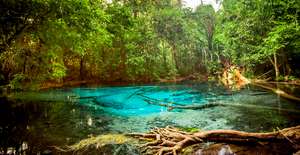
Assessment of mangrove environmental safety by analyzes of metals transition.
Reading Time: 12 min. Download (.pdf)
UDC 504.064.2
Assessment of mangrove environmental safety by analyzes of metals transition
Tetiana KRYVOMAZa*, Iryna ANDRUSISHINAb
aKyiv National University of Construction and Architecture, Vozduhoflotsky Avenue 31, Kyiv, 03680, Ukraine
b State Organisation “Institute of Labor Medicine” AMS of Ukraine st. Saksaganskogo 75, Kyiv, 01033, Ukraine
*Corresponding Author, e-mail: ecol@i.ua
Abstract. The study of metals transition in mangrove biome by analyzes of element concentration in plant, myxomycetes and soil for preliminary assessment of environmental safety. Methodology. Samples of soil, leaves litter, steam of living palm and myxomycetes fruiting body from Seychelles mangrove biome on Praslin island were analyzed by method of inductively coupled plasma atomic emission spectroscopy. Results. The scheme of 11 elements (Al, Ca, Cd, Cu, Fe, Mg, Mn, Ni, Pb, Si, Zn) accumulation demonstrates that heavy metals concentration increases in the direction from substrates to myxomycetes, and it decline from the forest floor to the trees. The ability myxomycetes Hemitrichia serpula accumulate Ca (Km-s = 443,69) and Zn (247,41) from environment was discover; Ni (60), Mn (16,04) and Pb (11,94) also show high level elements concentration in compere with their content in soil. The research finds big transformation ratio soil elements to mobile forms of soil for Fe (253,81) and Cu (105,45). Originality. For the first time the elements concentration in plant, myxomycetes and soil in mangrove were analyzed from ecological safety point of view. Practical value. Myxomycetes have undiscovered potential for bioindications and bioremediation of heavy metal and environmental management. References 10, no tables, figures 5.
Keywords: environmental safety, mangrove, myxomycetes, certification.
- Introduction
Mangrove is unique ecosystem where problems of nature protection and environmental safety are closely related. It is provide a wide range of goods and ecosystem services with great economic consequences such us a source of food and income outputs [1]. The vital mangrove role is in efforts fight climate change, protection from damage caused by tsunami waves, erosion and storms [2]. Mangrove is doing treatment of aquaculture and sewage effluents from toxins and nutrients of wastewater by bound particles or within the molecular lattice of clay particles and sediment deposition [3]. The mangrove biome characterized by fine sediments often with high organic content collect in areas protected from high-energy wave action. A habitat is made up of physical factors such as soil, moisture, range of temperature, and availability of light, etc. The most strong nature abiotic factors affecting mangrove biome are high salinity, frequent tidal inundation and anoxia, concerning mangrove developed physiological adaptations for overcome the problems [3].They contain a complex salt filtration system and complex root system. Mangrove environments created by trees and shrubs species growing in coastal saline or brackish water. It is provide a number of essentials for many different living organisms such as crabs, fish, coral, algae, lobsters, oysters, barnacles, shrimps, sponges, bryozoans and also bacteria, fungi, termites, myxomycetes.
Some common myxomycetes species (plasmodial slime molds or myxogastrids) live in this ecosystem and playing important role in nutrient cycle as members of the detritus food chain. One of ecological role of these organisms is utilizing organic matter, they have ability elements transformation and absorption [4]. Some myxomycetes appear to be tolerant of high levels of heavy metals and apparently accumulate them vigorously [5, 6]. Because myxomycetes are ubiquitous and accumulate material only from their immediate environment, they can be using in biomonitoring heavy metal contamination in environmental safety [7].
The concentration of metals depends not only on the biological characteristics of the species and the phases of their development, but also on the environmental situation in the area of their occurring, in this connection the resistance of myxomycetes to overage heavy metals may have different mechanisms. The fine, anoxic sediments under mangroves act as sinks for a variety of heavy (trace) metals which colloidal particles in the sediments have scavenged from the water. Mangrove removal disturbs these underlying sediments, often creating problems of trace metal contamination of seawater and biota [3]. “Environmental safety passports of species” appears universal platform for impersonal evaluating of risk with accounting the interests and tasks of environmental safety and nature protection [8]. It is accumulate veracious scientific information about individual species and evaluation of risk probability of real and potential threatens from this organism to environment, humans and other bioobjects [9].
The purpose of this work is study of metals transition in mangrove biome by analyzes of element concentration in plant, myxomycetes and soil for preliminary assessment of environmental safety.
- Material and Result of Research
Material for this research was collected during June and July 2015 in Seychelles mangrove biome on Praslin island. Samples of soil, leaves litter, steam of living palm and myxomycetes fruiting body were analyzed by method of inductively coupled plasma atomic emission spectroscopy (ICP-AES) to determine concentration of 11 elements: Al, Ca, Cd, Cu, Fe, Mg, Mn, Ni, Pb, Si, Zn. For assessment of accumulation the transition index using:

where Kt – transition index of heavy metals; C1 – heavy metals concentration in specimen 1; C2 – heavy metals concentration in specimen 2. Coefficient of elements accumulation in one specimen compared to other specimen were calculated for myxomycetes Hemitrichia serpula (Scop.) Rostaf., substratum where it create fruiting body (leaves litter and steam of living palm) and soil:
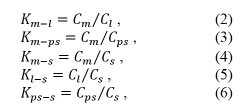
where K – index accumulation of elements in myxomycetes fruiting body compared to: Km-l – their substratum leaves litter, Km-ps – their substratum palm steam, Km-s – soil near place of collecting; Kl-s – index accumulation of elements in leaves litter compared to soil; Kps-s – index accumulation of elements in palm steam compared to soil; C – elements concentration: Cm – in myxomycetes, Cl –in leaves, Cps – in palm steam, Cs – in soil.
In additional the transformation ratio elements from soil mobile forms analyzed:

where K – index comprehensibility of elements from mobile forms of soil by myxomycetes (Km-mf), leaves (Kl-mf), palm steam (Kps-mf),Cmf – elements concentration in mobile forms of soil. Elements in mobile forms of soil becoming accessible for other living organisms and have potential ability return to nutrient cycle.
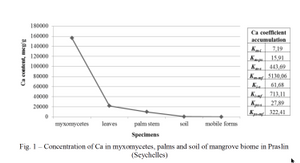
From 11 analyzed elements the highest concentration was discovering for Ca. Particularly myxomycetes has an enormous affinity for this element – 156312,9 mcg/g, compared to it substratum: 21728,43l mcg/g – in leaves litter and 9823,94 mcg/g – in palm steam (fig.1). It contains on the average 440 times more than the soil and transformation ratio elements from soil mobile forms is 5130,06. However this index also high for leaves (Kl-mf =713,11) and palm steam (Kps-mf=322,41). This is not surprising, insofar as Ca plays an important role in many vital functions of living organisms.
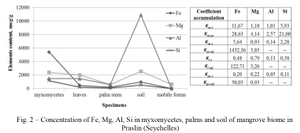
Next group of elements with high accumulation level includes Fe, Mg, Al and Si (fig.2). Noteworthy that for Al and Si didn’t find mobile forms of soil, so these elements in theory not accessible for living organisms. Nevertheless they was discovering in myxomycetes (1478,40 mcg/g), palm leaves (1460,99 mcg/g) and steam (574,79 mcg/g). Besides Al concentration in Hemitrichia serpula and litter on the average nearly three times more than the steam of living palms. Notwithstanding Al is only element in this study, which concentration in soil has dramatically large than in analyzed living organism – 10895,91 mcg/g. Contains of Si in soil (513,65 mcg/g) also exceed than in palm leaves (197,37 mcg/g) and steam (55,69 mcg/g), but it is twice less then in myxomycetes (1169,54 mcg/g). Concentration Mg in soil (2555,17 mcg/g) comparable, but slightly exceeds it in Hemitrichia serpula (2376,00 mcg/g) and leaves litter (2013,42 mcg/g), however it is more than four time average in palm steam (573,92 mcg/g). From other side this is comparable with Mg mobile forms of soil (617,7 mcg/g). Fe accumulated by myxomycetes (5400,00 mcg/g) as evidenced by the index comprehensibility of elements from mobile forms of soil Km-mf= 1432,36, but concentration Fe in soil (956,88 mcg/g) only in 5 time less than in Hemitrichia serpula. Contains of this element in palm leaves and steam intermediate value: Cl = 462,62, Cps = 188,63 mcg/g.
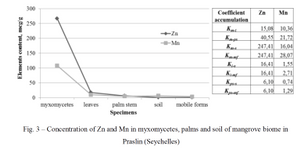
Common for Zn and Mn is approximately resembling level of concentration in leaves (17,72 mcg/g for Zn and 10,48 – Mn) steam (6,59 mcg/g for Zn and 5,00 – Mn), soil (1,08 mcg/g for Zn and 6,77 – Mn) and mobile forms (1,08 mcg/g for Zn and 3,87 – Mn). At the same time the accumulating capacity by myxomycetes (267,20 mcg/g for Zn and 108,62 – Mn) is clearly expressed (fig.3). For myxomycetes index comprehensibility of Zn from mobile forms of soil (247,41) is more than hundreds times than the same for palm leaves (16,41) and steam (6,10). They suggested that the metal probably affords protection from some more dangerous factor by acting as an enzyme activator in detoxification systems. May be Hemitrichia serpula has the same mechanism of Zn resistance, as other myxomycetes Fulifo septica. Both this species have yellow color of fruiting bodies, but for Fulifo septica known a yellow pigment called fuligorubin A, which has been shown to chelate metals and convert them to inactive forms [10].
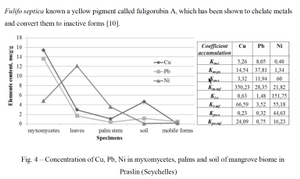
The content of Cu, Pb and Ni in mobile forms of soil are less than one mcg/g: Cu – 0,044, Pb – 0,48, Ni – 0,22. Nonetheless in fruiting body of Hemitrichia serpula accumulated 15,41 mcg/g Cu, 13,61 mcg/g Pb and 4,80 mcg/g Ni. The index comprehensibility of Cu from mobile forms of soil by myxomycetes is 350, 23 (fig.4). Pb also exclusively accumulated only in Hemitrichia serpula: Km-mf = 350,23 and Km-s = 66,56. Interesting that concentration Ni in leaves litter (12,14 mcg/g) nearly on 152 times more than in soil. These elements accumulate in living organisms more than in soil and possible their income source is anthropogenic pollution.
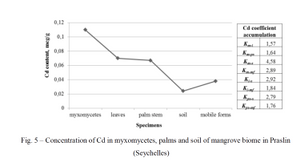
In much lesser but still significant amounts Cd were found in myxomycetes (0,11 mcg/g), leaves litter (0,07 mcg/g) and palm stem (0,07 mcg/g) in amounts a bit greater than in soil (0,02 mcg/g) and mobile forms of soil (0,04 mcg/g).
Conclusions
Mangrove ecosystem was analyzed from ecological safety point of view. Living organisms involved in all of the elementary soil and biological processes that directly or indirectly affect the mobility of trace elements. The deformation of the biogeochemical cycles with chemical environmental pollution can destabilize many processes in ecosystems. The proportionality between content of element in soils and their removal to living organisms is direct not for all elements. The assessment of heavy metal accumulation by myxomycetes shows the importance of these organisms for environmental safety monitoring.
- The scheme of element accumulation demonstrates that heavy metals concentration increases in the direction from substrates to myxomycetes, and it decline from the forest floor to the trees.
- Myxomycetes have undiscovered potential for bioindications and bioremediation of heavy metal and environmental management.
- The ability myxomycetes Hemitrichia serpula accumulate Ca (Ka = 443,69) and Zn (247,41) from environment was discover; Ni (60), Mn (16,04) and Pb (11,94) also show high level elements concentration in compere with their content in soil.
- The research finds big transformation ratio soil elements to mobile forms of soil for Fe (253,81) and Cu (105,45). Accordingly component of soil in mangrove make this metal accessible for other living organisms, including Fe and Cu to nutrient cycle.
- The assessment of heavy metal accumulation in mangrove soil and biotic components shows the anthropogenic impact by recreational disturbance and pollution on Praslin.
References
- Alongi D.M., 2009. Paradigm shifts in mangrove biology. In: Coastal Wetlands: an integrated ecosystem approach. Amsterdam, Elsevier Science, 615-640
- Dahdouh-Guebas F., Jayatissa L.P., Di Nitto D., Bosire J.O., Lo Seen D., Koedam N., 2005. How effective were mangroves as a defence against the recent tsunami? Current Biology, 15 (14), 1337-1338
- Popp M., Polania J., Weiper M., 1993. Physiological adaptations to different salinity levels in mangrove. Towards the rational use of high salinity tolerant plants, 27, 217-224
- Adl M. S., Gupta V. V. S. R., 2006. Protists in soil ecology and forest nutrient cycling. Canadian Journal of Forest Research. 36, 1805–1817.
- Stijve, T., Andrey D., 1999. Accumulation of various metals by Fuligo septica (L) Wiggers and by some other slime molds (myxomycetes). Australasian Mycologist, 18(2), 23–26.
- Zhulidov, D.A., Robarts R.D., Zhulidov A.V., Zhulidova O.V., Markelov D.A., Rusanov V.A., Headley J.V., 2002. Zinc Accumulation by the Slime Mold Fuligo septica (L.) Wiggers in the Former Soviet Union and North Korea. Journal of Environmental Quality, № 31, 1038–1042.
- Kryvomaz T., 2014 Evaluation of model objects for developing of "Environmental safety passports of species". Ecologichna bezpeka ta prirodokoristuvannya, 16, 32-39 (in Ukrainian).
- Kryvomaz T., 2015. Certification of species in the management of environmental safety. Scientific Herald of Ivano-Frankivsk National Technical University of Oil and Gas, 1(11), 149-154 (in Ukrainian).
- Kryvomaz T., Voloshkina O., 2014. The Risk Assessment of Threats from Biological Objects in Environmental Safety. Motrol: kom. Mot. Energ. Roln., OL PAN, Vol.16-8, 137-144.
- Latowski D, Lesiak A, Jarosz-Krzeminska E, Strzalka K. 2008. Fuligo septica, as a new model organism in studies on interaction between metal ions and living cells. Metal Ions in Biology and Medicine and Medicine, 10, 204–209.







Comments